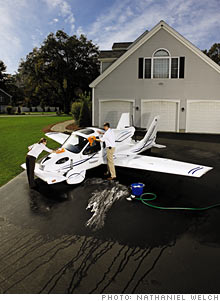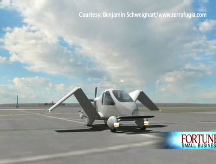The car of the future: It flies
Get ready, Detroit - this small firm is keeping up with the Jetsons.
 |
| Since the Wright brothers, there have been more than 100 attempts to build drivable planes or flying cars. They all failed commercially. |
(Fortune Small Business) -- Carl Dietrich always dreamed of building a flying car. Instead, the pragmatic inventor ended up creating what he calls a roadable aircraft, a plane that folds up its wings on landing and takes to the highway. In 2010, after three years of development, his vehicle, the Transition, will be available to customers for $194,000 a pop.
Terrafugia, the Woburn, Mass. company behind the Transition, began as an extracurricular activity for Dietrich while he was completing his Ph.D. in aeronautics and astronautics at MIT. Dietrich, 31, knew from the start that the odds were stacked against his project. Since the time of the Wright brothers, there have been more than 100 attempts to build drivable planes or flying cars. All have failed commercially.
"The basic problem is simple: A car is heavy, a plane is light," says Lionel Salisbury, publisher of the Roadable Times, a Web site devoted to chronicling flying-car attempts. "The two don't go together well."
Dietrich's early sketches envisioned a plane that would be driven rather than an automobile that took flight. At every step of the process, he was guided by the need to create something to be used in today's world, not tomorrow's.
So he and his team designed the Transition with regular car tires instead of aircraft tires. When the wings are folded up, the craft can park in a typical home garage, and it even runs on premium gasoline rather than aviation fuel. "We knew we could build it," Dietrich says. "The question was, 'Can we make money on it?' The key was not to base the business plan around a market that is not real."
Transition's design team studied the history of similar machines and the inventors who failed to bring their concepts to market. The most notable was Moulton "Molt" Taylor, a former Navy pilot who designed his first Aerocar in 1949, launched it in 1956 and produced a grand total of six vehicles.
Terrafugia concluded that the Aerocar failed because it was too difficult to convert from plane to car. "You had to unbolt the wings and reassemble them into a trailer," says Anna Mracek Dietrich, Carl's wife and the company's COO.
Terrafugia doesn't lack for competitors. In Los Angeles, Icon Aircraft is currently marketing a towable light aircraft that is amphibious (price tag: $139,000). In Alvin, Texas, LaBiche Aerospace has developed a flying sports car, which is classified as an experimental aircraft, and is taking orders for the $175,000 kits. Milner Motors, a father-and-son team based in Vancouver, Wash. and Bethesda, Md., is working on a prototype for a drivable plane that it expects to sell for $450,000. Publicly traded Moller International (MLER) in Davis, Calif. has designed a personal aircraft that takes off and lands vertically. (Moller is not yet taking deposits.) There are others as well, but Terrafugia appears to be further along than most in bringing its product to market.
The bulk of Terrafugia's initial funding - much of Carl Dietrich's $30,000 Lemelson-MIT Student Prize for outstanding innovation - was spent building a Transition prototype. Dietrich found some of his first investors at AirVenture Oshkosh, a festival that the Experimental Aircraft Association sponsors every August in Oshkosh, Wis. By December 2006 the company had secured several hundred thousand dollars in convertible notes. Since then, Terrafugia has completed five other convertible-note financings and recently closed its first round of equity financing. Another round is planned for 2009.
Terrafugia plans to manufacture the Transition in-house for now, although the Dietrichs aren't opposed to partnering with a larger manufacturer in the future. Meanwhile, they're negotiating with the Federal Aviation Administration and the U.S. Department of Transportation to settle on a design that satisfies both aircraft and auto regulators. That doesn't even begin to address the substantial insurance challenges.
"The auto insurance people and the aircraft insurance people don't even talk to each other," says Richard Gersh, a former insurance industry executive and Terrafugia's vice president of business development.
The FAA gave Terrafugia a boost in 2004, when it relaxed structural and maintenance requirements for ultralight planes by adopting the Sport Pilot and Light-Sport Aircraft Rule. This allowed experimental aircraft designers to push the technological envelope.
In the next five years, Dietrich hopes to sell a few hundred Transitions, mostly to wealthy private pilots and professionals who need to make short but regular flights. As FSB went to press, Terrafugia had gathered 40 deposits and its order backlog totaled more than $8 million.
While the company doesn't anticipate mainstream adoption of the Transition, Dietrich does expect an envy factor: "You see it in your neighbor's driveway," he says, "and you realize that he has a freedom you lack." ![]()
Full package: Next Little Thing 2009
Where are they now? See how out past Next Little Things have done.
Practical Dreamer: Paul Moller hasn't built a flying car - yet. But as he chases that goal, he's selling off other ideas.
Be a pilot in 20 hours
-
The Cheesecake Factory created smaller portions to survive the downturn. Play
-
A breeder of award-winning marijuana seeds is following the money and heading to the U.S. More
-
Most small businesses die within five years, but Amish businesses have a survival rate north of 90%. More
-
The 10 most popular franchise brands over the past decade -- and their failure rates. More
-
These firms are the last left in America making iconic products now in their twilight. More









